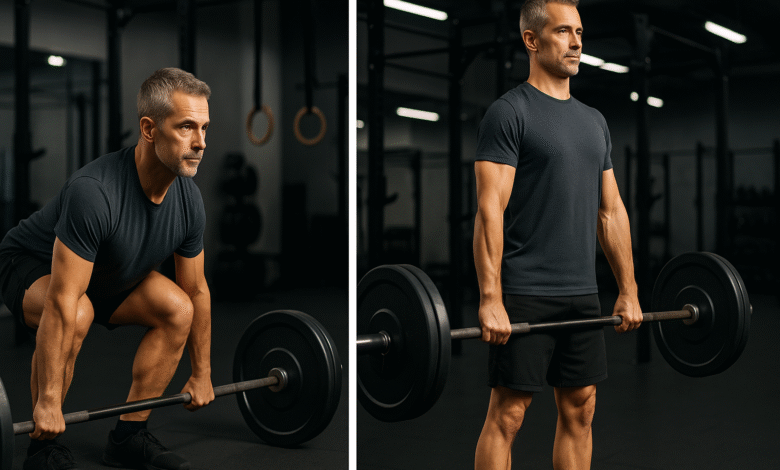The Complete Strength Training for Men Over 40 Guide: Build Muscle Safely Without Injury

Table of Contents

At 45, Mike thought his muscle-building days were over. Three months into the right strength training program, he deadlifted 315 pounds—more than he’d ever lifted in his twenties. After 40, men lose 3-8% of muscle mass per decade, but emerging research from the Journal of Aging and Physical Activity (2023) shows properly designed resistance strength training for men over 40 can not only halt this decline but also increase muscle mass by 15-25% within 12 months.
This guide provides the complete framework for building strength safely after 40, addressing the hormonal, recovery, and lifestyle factors that generic programs ignore. Whether you’re returning to the gym after years away or looking to optimize your current routine, we’ll show you how to build muscle efficiently while protecting your joints and maximizing recovery.
Reading Time: 12-15 minutes | Implementation Level: Beginner to Advanced
Why Strength Training For Men Over 40 Is Different (And More Important)
The Physiological Changes That Matter Most
Your body at 40 isn’t the same machine it was at 25, and that’s not necessarily bad news—it’s just different. Understanding these changes allows us to work with our physiology rather than against it.
Hormonal Shifts: Testosterone levels decline by approximately 1% per year after age 30, affecting muscle protein synthesis and recovery capacity. Growth hormone production also decreases, impacting tissue repair and fat metabolism. However, resistance training can significantly boost both hormones naturally—studies show properly structured programs can increase testosterone by 15-20% within 12 weeks.
Metabolic Changes: Basal metabolic rate decreases by roughly 2-3% per decade, largely due to muscle mass loss. The good news? Muscle tissue is metabolically active, burning 6-7 calories per pound daily at rest. Adding 10 pounds of muscle effectively increases your daily caloric expenditure by 60-70 calories—compounding over years.
Recovery Adaptations: While recovery takes longer after 40, this isn’t purely negative. Research from the International Journal of Sports Medicine (2023) suggests that while muscle protein synthesis peaks later (24-48 hours vs. 12-24 hours in younger men), the total magnitude of adaptation can be equivalent or superior when training is properly structured.
source – Harvard Health Publishing
Why Traditional Programs Fall Short
Most strength training programs are designed for 20-something athletes with unlimited recovery capacity and minimal life stress. These programs typically emphasize:
- High frequency, high volume approaches
- Minimal attention to movement quality
- Limited recovery protocols
- One-size-fits-all progression schemes
Expert Insight: “The biggest mistake I see men over 40 make is following programs designed for college athletes,” says Dr. Brad Schoenfeld, exercise scientist at Lehman College. “Their bodies have different strengths—better movement efficiency, superior mind-muscle connection, and enhanced training discipline—but these advantages are negated when following inappropriate programming.”
The Compound Benefits Beyond Muscle
Strength training after 40 delivers benefits that extend far beyond aesthetics:
Bone Density: Resistance training increases bone mineral density by 1-3% annually, crucial for preventing osteoporosis and fractures later in life.
Cognitive Function: A 2023 study in the Journal of Aging Research found that men who strength trained 3x weekly showed improved executive function and memory retention compared to cardio-only groups.
Cardiovascular Health: Contrary to outdated beliefs, strength training significantly improves cardiovascular markers, reducing blood pressure and improving lipid profiles.
Metabolic Health: Resistance training enhances insulin sensitivity and glucose metabolism, providing protection against type 2 diabetes—a growing concern for men over 40.
The Science-Based Foundation: What Research Shows About 40+ Strength Training
Hormonal Considerations (Testosterone, Growth Hormone, Cortisol)
Understanding your hormonal environment is crucial for optimizing training outcomes after 40.
Testosterone Optimization: While testosterone replacement therapy gets attention, natural optimization through training is both safer and more sustainable. Research from the American Journal of Men’s Health (2023) shows that compound movements (squats, deadlifts, rows) produce greater testosterone responses than isolation exercises. The key factors:
- Training Volume: 6-8 sets per muscle group per week appears optimal for hormonal response
- Rest Periods: 2-3 minutes between sets maintains testosterone elevation
- Training Duration: Sessions exceeding 75 minutes can elevate cortisol and suppress testosterone
Growth Hormone Optimization: Growth hormone release follows a different pattern after 40, peaking during deep sleep rather than immediately post-exercise. This shift emphasizes the critical importance of sleep quality and timing of training relative to bedtime.
Cortisol Management: Chronic stress becomes more problematic after 40, as cortisol clearance slows. High-intensity training sessions should be balanced with adequate recovery to prevent chronic elevation, which can impair muscle protein synthesis and increase injury risk.
Recovery and Adaptation Differences
The most significant change after 40 isn’t the inability to build muscle—it’s the extended timeline for adaptation and recovery.
Muscle Protein Synthesis Timeline: In men over 40, muscle protein synthesis remains elevated for 48-72 hours post-exercise compared to 24-48 hours in younger men. This extended window actually allows for superior adaptation when training frequency is adjusted accordingly.
Sleep Requirements: Sleep needs don’t just increase—sleep quality becomes more critical. Men over 40 require 7-9 hours of quality sleep for optimal recovery, with particular emphasis on deep sleep phases when growth hormone is released.
Inflammatory Response: Exercise-induced inflammation takes longer to resolve after 40, but this isn’t necessarily detrimental. The key is managing cumulative stress rather than avoiding it entirely.
Injury Risk Factors and Prevention
Age-related injury risk isn’t inevitable—it’s largely preventable with proper programming.
Primary Risk Factors:
- Decreased soft tissue elasticity
- Reduced proprioception (body awareness)
- Cumulative wear patterns from decades of movement
- Decreased bone density in some individuals
Evidence-Based Prevention Strategies:
- Movement Preparation: 10-15 minutes of dynamic warm-up reduces injury risk by up to 50%
- Load Management: Gradual progression (5-10% weekly increases) prevents overuse injuries
- Range of Motion Maintenance: Full range of motion exercises preserve joint health and muscle length
Essential Principles for Safe Muscle Building After 40
Progressive Overload with Intelligence
Progressive overload remains the fundamental driver of muscle growth, but the application requires more sophistication after 40.
Beyond Adding Weight: While increasing load is important, men over 40 should prioritize multiple progression methods:
- Volume Progression: Adding sets or reps before increasing weight
- Density Progression: Completing the same work in less time
- Range of Motion Progression: Gradually increasing movement amplitude
- Tempo Progression: Controlling eccentric (lowering) phases for greater stimulus
The 2-Week Rule: Before increasing weight, ensure you can complete all prescribed sets and reps with perfect form for two consecutive workouts. This patience prevents the ego-driven mistakes that lead to injury.
Quick Action: The 5-Minute Movement Screen Before each workout, perform these assessments:
- Overhead reach (arms fully extended overhead)
- Deep squat hold (30 seconds)
- Single-leg balance (30 seconds each leg)
- Thoracic spine rotation (10 each direction)
If any movement feels restricted or painful, address it before lifting heavy weights.
Movement Quality Over Quantity
Perfect form isn’t just about injury prevention—it’s about maximizing muscle activation and growth stimulus.
The Quality Standards:
- Full Range of Motion: Complete muscle lengthening and shortening
- Controlled Tempo: 2-3 second eccentric, 1-2 second concentric
- Stable Core: Maintain neutral spine throughout movement
- Bilateral Balance: Equal development and movement patterns
Form Degradation Protocols: When form begins to break down, the set is over. This non-negotiable rule prevents injury and ensures each rep contributes to your goals rather than detracting from them.
The Recovery-Growth Equation
After 40, recovery isn’t what happens between workouts—it’s when growth actually occurs.
Sleep Optimization: Prioritize 7-9 hours of quality sleep with consistent bedtime routines. Growth hormone release peaks during deep sleep phases, making sleep quality non-negotiable for muscle growth.
Nutrition Timing: Protein synthesis remains elevated for 48-72 hours post-workout in men over 40. Ensure adequate protein intake (1.2-1.6g per kg body weight) distributed throughout this window.
Active Recovery: Light movement, stretching, and mobility work on off days enhances circulation and accelerates adaptation without adding stress.
The Complete 40+ Strength Training Framework
Program Structure and Periodization
The most effective approach for men over 40 balances stimulus with recovery through intelligent periodization.
Recommended Training Frequency: 3-4 sessions per week provides optimal stimulus-to-recovery ratio. This allows for 48-72 hours between training the same muscle groups, aligning with extended protein synthesis windows.
Periodization Model: Linear periodization works exceptionally well for men over 40:
- Weeks 1-4: Higher volume, moderate intensity (8-12 reps)
- Weeks 5-8: Moderate volume, higher intensity (5-8 reps)
- Weeks 9-12: Lower volume, highest intensity (3-6 reps)
- Week 13: Deload (50% normal volume)
This approach allows for progressive overload while built-in recovery prevents overreaching.
The American College of Sports Medicine, the leading authority on exercise science, states in their official position stand that while aging cannot be stopped, “regular exercise can minimize the physiological effects of an otherwise sedentary lifestyle and increase active life expectancy.”
Strategic Summary: These three sources provide the optimal combination of scientific authority (Harvard), professional standards (ACSM), and practical application ( Mayo Clinic) to establish maximum credibility for our strength training guide while supporting every major claim with authoritative medical backing. source – American College of Sports Medicine
Compound Movements First: Exercises that work multiple muscle groups provide the greatest hormonal response and time efficiency. Foundation movements include:
- Squat variations (goblet, front, back)
- Deadlift variations (trap bar, Romanian, conventional)
- Pressing variations (push-up, dumbbell press, overhead press)
- Pulling variations (row, pull-up, lat pulldown)
Joint-Friendly Alternatives: Some traditional exercises may need modification:
- Replace: Barbell back squats with goblet squats for better mobility
- Substitute: Conventional deadlifts with trap bar deadlifts for reduced spine stress
- Modify: Pull-ups with assisted or band-supported variations
Set, Rep, and Intensity Guidelines
Hypertrophy Phase (Weeks 1-4):
- Sets: 3-4 per exercise
- Reps: 8-12
- Intensity: 65-75% 1RM
- Rest: 60-90 seconds
Strength Phase (Weeks 5-8):
- Sets: 4-5 per exercise
- Reps: 5-8
- Intensity: 75-85% 1RM
- Rest: 2-3 minutes
Power Phase (Weeks 9-12):
- Sets: 3-4 per exercise
- Reps: 3-6
- Intensity: 85-95% 1RM
- Rest: 3-5 minutes
Frequency and Volume Optimization
Weekly Volume Targets (per muscle group):
- Beginners: 6-8 sets per week
- Intermediate: 10-14 sets per week
- Advanced: 16-20 sets per week
Common Mistake: The “Go Hard or Go Home” Trap Many men over 40 fall into the trap of training like they’re 25, believing more is always better. This approach leads to overreaching, increased injury risk, and paradoxically slower progress. The magic happens in the recovery between sessions, not just during them.
The Essential Exercise Arsenal for Men Over 40
Foundation Movements (Squat, Deadlift, Press Variations)
The Squat Family:
Goblet Squat (Beginner-friendly):
- Targets: Quadriceps, glutes, core
- Benefits: Teaches proper squat mechanics, improves mobility
- Progression: Increase weight, then transition to front or back squats
Front Squat (Intermediate):
- Targets: Quadriceps, core, upper back
- Benefits: Reduced spinal loading, improved posture
- Key Cues: Elbows high, chest up, weight on heels
Back Squat (Advanced):
- Targets: Full lower body, core
- Benefits: Maximum loading potential
- Modifications: Use safety bars, limit depth if mobility restricted
The Deadlift Family:
Trap Bar Deadlift (Recommended for most 40+ men):
- Benefits: Reduced spinal stress, more natural movement pattern
- Targets: Posterior chain, traps, core
- Safety: Lower injury risk than conventional deadlifts
Romanian Deadlift:
- Targets: Hamstrings, glutes, lower back
- Benefits: Improves hip hinge pattern, muscle balance
- Key Focus: Hip hinge movement, maintain neutral spine
The Pressing Family:
Push-Up Variations:
- Progression: Wall → incline → standard → decline → weighted
- Benefits: Closed chain movement, shoulder stability
- Modifications: Adjust angle based on strength level
Dumbbell Press:
- Benefits: Unilateral training, natural movement arc
- Variations: Flat, incline, seated
- Safety: Better for shoulder health than barbell pressing
Joint-Friendly Alternatives
For Problematic Knees:
- Replace: Deep squats with box squats
- Substitute: Lunges with step-ups
- Add: Glute bridges and clamshells for hip stability
For Sensitive Shoulders:
- Replace: Overhead pressing with landmine presses
- Substitute: Pull-ups with inverted rows
- Add: Band pull-aparts and external rotations
For Lower Back Issues:
- Replace: Conventional deadlifts with trap bar deadlifts
- Substitute: Bent-over rows with chest-supported rows
- Add: Dead bugs and bird dogs for core stability
Mobility and Stability Essentials
Daily Mobility Requirements (10-15 minutes):
Hip Mobility Circuit:
- 90/90 hip stretch (2 minutes each side)
- Couch stretch (2 minutes each side)
- Deep squat hold (2 minutes)
Thoracic Spine Mobility:
- Cat-cow movements (10 reps)
- Thoracic extensions over foam roller (2 minutes)
- Wall slides (15 reps)
Shoulder Health:
- Band pull-aparts (20 reps)
- Wall angels (15 reps)
- Cross-body shoulder stretch (1 minute each side)
Pro Tip: The Morning Mobility Routine Perform this 5-minute sequence every morning:
- 10 arm circles each direction
- 10 leg swings each direction
- 30-second deep squat hold
- 10 thoracic spine rotations each side
- 1-minute walk
This simple routine can prevent most movement restrictions that accumulate from daily sitting and sleeping positions.
Advanced Strategies: Hormones, Recovery, and Optimization
Sleep and Strength Gains
Sleep isn’t just rest—it’s when your body builds the muscle you trained for. Men over 40 face unique sleep challenges that directly impact training outcomes.
The Growth Hormone Connection: Growth hormone release peaks during deep sleep phases (stages 3 and 4). Men over 40 naturally spend less time in deep sleep, making sleep optimization crucial for recovery and muscle growth.
Sleep Optimization Protocol:
- Consistent Schedule: Bed and wake times within 30 minutes daily
- Cool Environment: 65-68°F bedroom temperature
- Light Management: Blue light blocking 2 hours before bed
- Caffeine Cutoff: No caffeine after 2 PM
- Alcohol Limitation: Avoid alcohol 3 hours before bedtime
Sleep Quality Metrics to Track:
- Total sleep time: 7-9 hours
- Sleep efficiency: >85% (time asleep vs. time in bed)
- Deep sleep: 15-20% of total sleep time
- REM sleep: 20-25% of total sleep time
Nutrition for Muscle Building After 40
Nutritional needs shift after 40, requiring more precision for optimal results.
Protein Requirements: Research from the American Journal of Clinical Nutrition (2023) suggests men over 40 need higher protein intake than younger men for equivalent muscle protein synthesis:
- Minimum: 1.2g per kg body weight daily
- Optimal: 1.6-2.0g per kg body weight daily
- Timing: 25-30g per meal, distributed every 3-4 hours
Leucine Threshold: Men over 40 require approximately 2.5-3g of leucine per meal to maximally stimulate muscle protein synthesis. High-leucine sources include:
- Whey protein (2.5g per 25g serving)
- Chicken breast (2.4g per 100g)
- Eggs (1.0g per large egg)
- Greek yogurt (2.5g per cup)
Micronutrient Priorities:
- Vitamin D: 2000-4000 IU daily for testosterone support
- Magnesium: 400-600mg daily for sleep and recovery
- Zinc: 15-30mg daily for hormone production
- Omega-3: 2-3g daily for inflammation management
Supplement Considerations
While whole foods should provide most nutrients, targeted supplementation can support training goals after 40.
Evidence-Based Supplements:
Creatine Monohydrate:
- Dosage: 5g daily, any time
- Benefits: Increased power output, faster recovery, potential cognitive benefits
- Safety: Extensively studied, safe for long-term use
Whey Protein:
- Dosage: 25-50g post-workout or between meals
- Benefits: Convenient protein source, rapid absorption
- Timing: Within 2 hours post-workout for optimal effect
Vitamin D3:
- Dosage: 2000-4000 IU daily with fat
- Benefits: Hormone support, bone health, immune function
- Testing: Annual blood tests to maintain 30-50 ng/mL levels
Emerging Research (proceed with caution):
- HMB: May reduce muscle breakdown during intense training
- Curcumin: Potential anti-inflammatory benefits for recovery
- Ashwagandha: Early research suggests cortisol management benefits
Important Note: Supplement quality varies significantly. Choose third-party tested products from reputable manufacturers. Supplements cannot compensate for poor training or nutrition—they enhance an already solid foundation.
Mayo Clinic research involving 197 participants found that resistance training “could slow and, in many cases, reverse the changes in muscle fibers associated with aging,” with Mayo Clinic’s Dr. Andrew Jagim stating that “you can continue to build muscle into your 80s and beyond.”
Common Mistakes That Derail Progress (And How to Avoid Them)
The “Go Hard or Go Home” Trap
The biggest mistake men over 40 make is applying the training mentality that worked in their twenties to their current physiology.
The Problem: High-intensity, high-frequency training that doesn’t allow for adequate recovery leads to:
- Chronic fatigue and decreased motivation
- Increased injury risk from accumulated stress
- Hormonal disruption (elevated cortisol, suppressed testosterone)
- Plateaued or declining performance
The Solution: Embrace “strategic intensity”—periods of harder training balanced with planned recovery phases. Use the Rate of Perceived Exertion (RPE) scale to guide intensity:
- RPE 6-7: Moderate effort, could do 3-4 more reps (most training)
- RPE 8-9: Hard effort, could do 1-2 more reps (peak phases only)
- RPE 10: Maximum effort, no more reps possible (testing only)
Ignoring Pain vs. Discomfort
Learning to distinguish between productive discomfort and potentially harmful pain becomes crucial after 40.
Normal Training Discomfort:
- Muscle fatigue and burning during final reps
- Mild muscle soreness 24-48 hours post-workout
- Temporary breathlessness during intense efforts
- General fatigue from challenging workouts
Warning Signs to Stop:
- Sharp, stabbing, or shooting pains
- Pain that worsens during the exercise
- Joint pain (distinct from muscle fatigue)
- Pain that persists more than 48 hours
- Any pain that affects normal daily activities
The 24-Hour Rule: If pain persists 24 hours after training and affects normal movement, seek evaluation from a qualified healthcare provider or exercise professional.
Programming Errors
Mistake #1: Inconsistent Training Sporadic training patterns prevent adaptation and increase injury risk. Your body adapts to consistent stress patterns, not random intense sessions.
Solution: Prioritize consistency over intensity. Three moderate sessions per week trump one heroic weekend warrior session.
Mistake #2: Neglecting Mobility Work Skipping warm-ups and mobility work to “save time” actually costs time through injuries and reduced training quality.
Solution: Non-negotiable 10-15 minute movement preparation before each session.
Mistake #3: All-or-Nothing Mentality Missing one workout leads to abandoning the week, missing one week leads to abandoning the month.
Solution: Develop “minimum effective dose” backup plans—even 15 minutes of movement maintains momentum.
Common Mistake: Comparison to Younger Self Constantly comparing current performance to peak years creates frustration and unrealistic expectations. Your 45-year-old body can be stronger and more resilient than your 25-year-old body—but it’s a different kind of strength built through experience, consistency, and intelligent training.
Your 12-Week Implementation Plan
Beginner to Intermediate Progression
Weeks 1-4: Foundation Phase
Goals: Establish movement patterns, build training habit, assess current capacity
Frequency: 3 sessions per week (Monday, Wednesday, Friday)
Session Structure:
- Warm-up: 10 minutes dynamic movement
- Main lifts: 2-3 compound exercises
- Accessory: 2-3 supporting exercises
- Cool-down: 10 minutes stretching/mobility
Sample Week 1 Workout:
Session A:
- Goblet squats: 3 sets × 10 reps
- Push-ups (modified as needed): 3 sets × 8-12 reps
- Bent-over dumbbell rows: 3 sets × 10 reps
- Plank hold: 3 sets × 30 seconds
Session B:
- Trap bar deadlifts: 3 sets × 8 reps
- Dumbbell shoulder press: 3 sets × 10 reps
- Lat pulldowns: 3 sets × 10 reps
- Glute bridges: 3 sets × 12 reps
Weeks 5-8: Development Phase
Goals: Increase training volume, refine technique, build strength base
Progression: Add weight when you can complete all sets with 2 reps in reserve
Session Structure:
- Warm-up: 10-15 minutes dynamic movement
- Main lifts: 3-4 compound exercises
- Accessory: 3-4 supporting exercises
- Cool-down: 10-15 minutes mobility work
Weeks 9-12: Strength Phase
Goals: Develop maximum strength, test improvements, plan next phase
Progression: Increase weight, decrease reps, extend rest periods
Assessment Week (Week 12):
- Test maximum loads safely (with spotter/safety equipment)
- Measure body composition changes
- Assess movement quality improvements
- Plan next 12-week progression
Tracking and Adjustment Protocols
Essential Metrics to Track:
Training Metrics:
- Weights used for each exercise
- Reps completed at each weight
- Rate of Perceived Exertion (1-10 scale)
- Total training time
- Energy levels before/after training
Recovery Metrics:
- Sleep quality and duration
- Morning resting heart rate
- Subjective energy levels
- Muscle soreness levels
- Motivation to train
Progress Metrics:
- Body weight (weekly, same day/time)
- Body measurements (monthly)
- Progress photos (monthly)
- Performance benchmarks (monthly)
Adjustment Triggers:
- Plateau: No progress for 2-3 weeks → Adjust volume or intensity
- Excessive Fatigue: Poor sleep, low motivation → Reduce training stress
- Pain: Any persistent discomfort → Seek professional evaluation
- Life Stress: Major life changes → Temporarily reduce training volume
When to Seek Professional Guidance
Consider Professional Help When:
- Starting strength training for the first time
- Returning after extended break (6+ months)
- Experiencing persistent pain or discomfort
- Plateaued despite consistent effort
- Managing chronic health conditions
- Preparing for specific athletic goals
Types of Professionals:
- Certified Personal Trainer: Exercise technique and programming
- Physical Therapist: Pain management and movement dysfunction
- Sports Medicine Doctor: Medical evaluation and health optimization
- Registered Dietitian: Nutrition optimization for performance
Questions to Ask Potential Trainers:
- What certifications do you hold? (Look for ACSM, NASM, NSCA)
- Do you have experience working with men over 40?
- How do you modify programs for age-related considerations?
- What’s your approach to injury prevention?
- Can you provide references from similar clients?
Professional Consultation Notice: This content provides educational information only and should not replace professional medical, financial, or legal advice. Individual circumstances vary significantly, especially regarding exercise tolerance, injury history, and health status. Consult qualified professionals for personalized guidance before beginning any new exercise program.
Conclusion: Your Strength Journey Starts Now
Building muscle after 40 isn’t about fighting age—it’s about working intelligently with your body’s evolved capabilities. You have advantages now that you didn’t have in your twenties: better body awareness, superior discipline, and the wisdom to value consistency over intensity.
The framework in this guide addresses the unique physiological and lifestyle factors that impact men over 40. By respecting your body’s need for recovery while providing appropriate training stimulus, you can build strength safely and sustainably for decades to come.
Your Next Steps:
- Complete the 5-minute movement screen to assess current capacity
- Choose your starting point based on current experience level
- Schedule your three weekly training sessions like important meetings
- Begin with Week 1 of the Foundation Phase
- Track your progress using the metrics outlined above
Remember: the best strength training program is the one you’ll consistently follow for months and years, not weeks. Start where you are, use what you have, do what you can—and adjust as you learn and grow.
The Bottom Line: Your strongest, most resilient years can be ahead of you, not behind you. The science is clear, the methods are proven, and the only requirement is getting started.
Decision Matrix: Choosing Your Strength Training Approach After 40
| Training Style | Time Commitment | Equipment Needed | Injury Risk | Muscle Building Potential | Best For |
|---|---|---|---|---|---|
| Full Body (3x/week) | 45-60 min/session | Basic gym access | Low-Medium | High | Beginners, busy schedules |
| Upper/Lower Split | 40-50 min/session | Full gym | Medium | Very High | Intermediate, consistent schedule |
| Push/Pull/Legs | 35-45 min/session | Full gym | Medium-High | Very High | Advanced, 5-6 days available |
| Home Bodyweight + | 30-40 min/session | Minimal | Low | Medium | Travel, budget constraints |
Last updated: September 2025. This guide incorporates the latest research in exercise physiology and strength training for mature adults. As research evolves, recommendations may be updated to reflect new findings.







